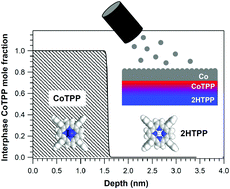Formation of an interphase layer during deposition of cobalt onto tetraphenylporphyrin: a hard X-ray photoelectron spectroscopy (HAXPES) study†
Abstract
The interface formation upon vapor deposition of a metal onto a molecular organic semiconductor was studied using a well-defined complexation reaction between a metal and a porphyrin. Specifically, metallic cobalt (Co) was vapor deposited onto a thin film of 2H-tetraphenylporphyrin (2HTPP) at room temperature. The resulting interface was probed with Hard X-ray Photoelectron Spectroscopy (HAXPES) using photon energies between 2 and 6 keV to obtain a detailed depth profile of the chemical composition. Characteristic changes in the N 1s core level signals reveal the formation of a cobalt tetraphenylporphyrin (CoTPP) layer between the Co and 2HTPP layers. Assuming an abrupt interface between CoTPP and 2HTPP (layer-by-layer model), analysis of the XPS data results in a thickness of the CoTPP reaction layer of 1.6 nm. However, a more advanced numerical analysis allowed us to reconstruct details of the actual depth distribution of the CoTPP interphase layer: up to a depth of 1.5 nm, all 2HTPP molecules were converted into CoTPP. Beyond this depth, the CoTPP concentration decreases sharply within 0.15 nm to zero.


 Please wait while we load your content...
Please wait while we load your content...